Travel in Mongolia with the Nomads of
the Wild West
Guest to a Great People, Culture and Land
Article and photos
by Lies Ouwerkerk
Senior
Contributing Editor
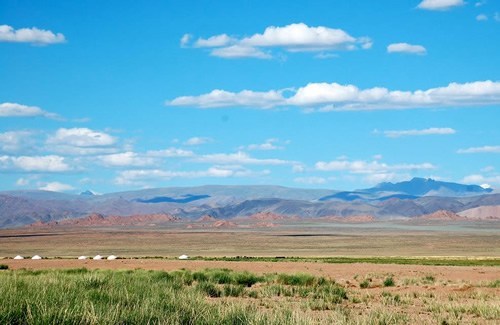
|
|
Gers in the distance dot the
country where the Mongolian nomads live and roam.
|
The small domestic airplane I have boarded
in Mongolia’s capital Ulaanbaatar is heading for Bayaan
Olgii, the westernmost province of the country, inhabited
by nomadic ethnic groups who still roam the steppes with
their herds, just as their ancestors have done for over
3,000 years.
From my window seat I can clearly see
the landscape below: endless plains without any roads, deep
blue lakes, mountains with some snow still clinging in the
shady spots of their highest ridges, and here and there
small clusters of light and dark dots: the gers, Mongolia’s
traditional dwellings, surrounded by nomads’ most precious
possessions — their livestock.
Guides
My guide Bekbolat and his cousin Haba,
who is making his debut as cook this trip, are waiting outside
Olgii’s airport with their Russian jeep, loaded to capacity
with food, water, camping equipment, and gasoline. Together
we will venture into unchartered territory, on the lookout
for chance encounters with Kazakh, Dorvod, and Khoton nomads.
The ethnically diverse nomads live entirely by and from
their livestock, and move their households at least three
times a year in search of the best pastures for their horses,
yaks, sheep, goats, and camels.
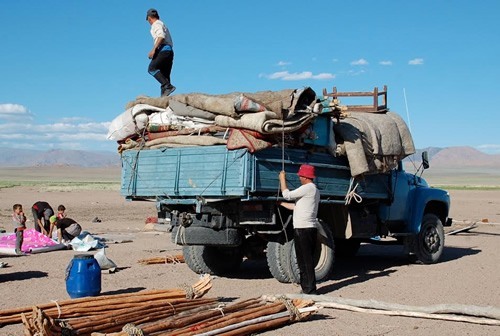
|
|
Loading up the truck.
|
Bekbolat, whose self-taught English
is admirable, and Haba are both Kazakhs who grew up as herders
in the Altai Mountains region. They were the first of their
families to attend high school, followed by a university
education in Ulaanbaatar. Bekbolat is an ex-high schoolteacher
and now full-time operator of his adventure expeditions;
Haba is an internationally competing boxer and will complete
his physical education degree after the summer. They will
not only guide, drive, set up camp and cook, but also serve
as go-betweens, interpreters, and sources of information
about Mongolia’s nomadic lifestyle, with first-hand experience
in eagle hunting, building gers, shearing sheep,
milking goats, wrangling horses, and finding their way in
no-man's land across mountains, rivers, and fenceless plains.
Nomads on the Move
As soon as we leave the built-up area
of Olgii behind, the paved road stops, and for a while we
follow the tire tracks scribed into the landscape by passing
vehicles before us.
It is the beginning of July, a time
when nomads often leave their spring locations to look for
greener pastures that will last their livestock until the
end of the summer season. As we advance into the wilderness,
we encounter several families on the move, some with blue
trucks, others on horseback, with a caravan of heavily loaded
camels in tow.
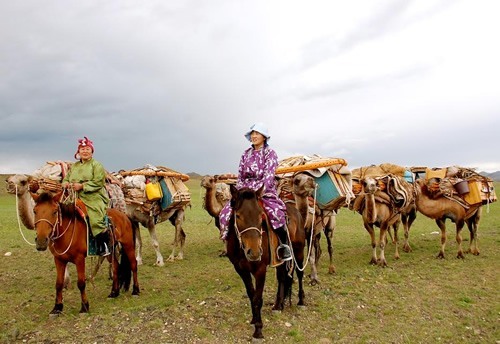
|
|
Meeting other Mongolian women
nomads along the way.
|
Invariably, the nomads take time out
for a chat. The women manage to conjure up some cookies,
bread, or curd. The men advise us where to camp without
being attacked by hordes of mosquitoes, and boast about
the little time it takes them (less than an hour) to dismantle
and pack their ger: the wall of lattice work, the roof poles,
the layers of felt and white cotton, and the ropes that
hold it all together.
Nomads’ Proverbial Hospitality
Our first surprise visit to a ger will
be characteristic for the many more to follow.
At the sound of our jeep, the head
of the family comes out to welcome and invites us inside
their cylindrical tent, also known as a yurt outside Mongolia.
We sit on heavy floor cushions in the corner farthest from
the door (which always faces south, because the cold wind
comes from the north), between an altar and a low coffee
table where the hostess serves us homemade bread, dried
goat cheese, and salty tea with yak milk. The family members
sit on carpets on the floor, or on the beds along the walls
that are decorated with a dazzling mosaic of colorful hangings
and embroideries, family photos, medals won in wrestling
matches and horse races, and animal skins commemorating
successful hunts.
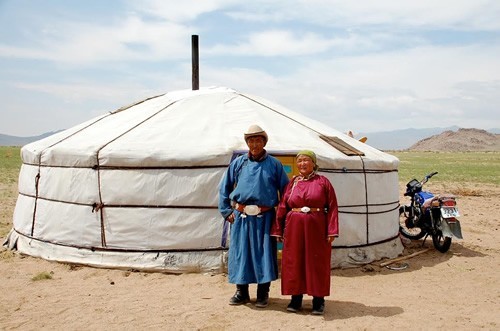
|
|
A family greets us as we arrive.
|
As a sign of respect, the host solemnly
hands me a little sniff bottle with a silver cap. I have
to hold it in vertical position in the palm of my hand with
the bung half-open, take a sniff, and then return it to
him in the same manner.
Meanwhile, the hostess has decided that
we must stay for lunch, and starts her preparations for
making noodles from scratch. She rolls, kneads and flattens
dough made from flour and water, then cuts it with a big
knife in small strips, which she cooks in a pot of boiling
mutton stock on the stove in the center of the ger.
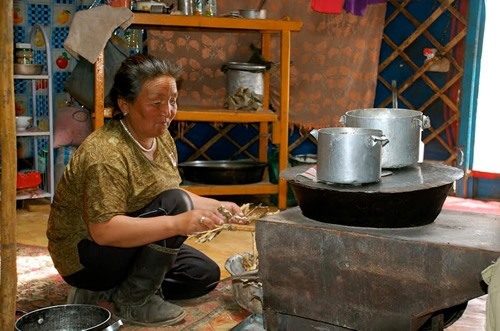
|
|
Mongolian host cooking
for us — part of the notorious hospitality.
|
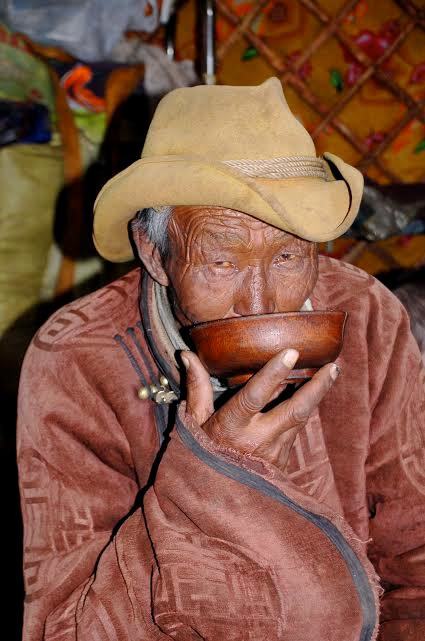
|
|
Husband enjoying the shared meal.
|
After the spontaneous meal and some
small gift giving, Bekbolat asks them to show their traditional
garments, and in no time they proudly appear in their festive
attire: leather cowboy boots and a long coat girdled with
a silk sash of contrasting color, or a leather belt with
a silver buckle. Their son wants to pose for the camera
in his national wrestling outfit, with all his medals around
his neck, and sports a pointed hat, leather boots, a small
tight-fitting red brief, and a tight short-sleeved jacket
in blue, exposing his chest. According to a legend, once
upon a time there was a woman disguised as man who defeated
all wrestlers and then ripped open her jacket to show them
she was a female; from that day on, wrestlers had to reveal
their chest to root out all women.
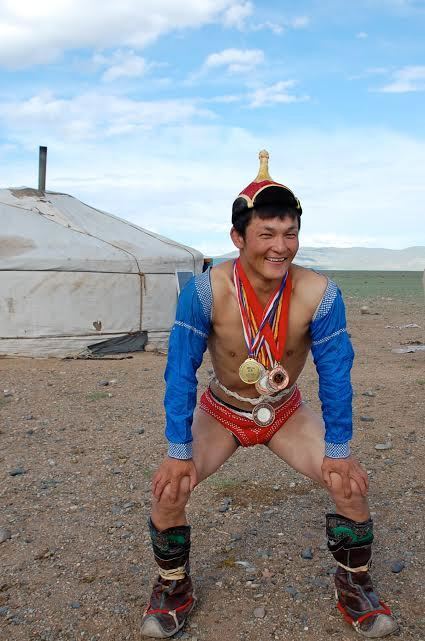
|
|
The son wants to pose for the
camera in his national wrestling outfit.
|
Visits
We also have curious visitors coming
to our tents: women on foot, magically coming out from nowhere
and carrying big bags of jute over their shoulders to collect
camel dung for their hearths, horse wranglers equipped with
miniature binoculars searching for their lost cattle, and
little boys on horsebacks without saddles in charge of herding
their family’s livestock. When Haba puts out our bread,
butter, and jam, they are initially a bit timid, but then
happily dig in.
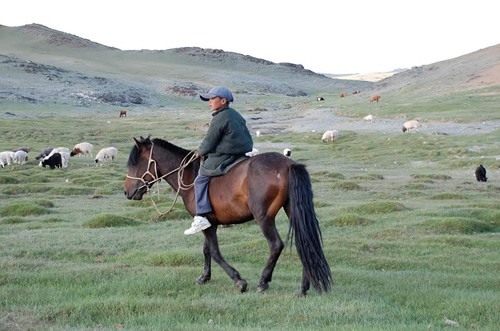
|
|
Boy on horseback passes by our
tent.
|
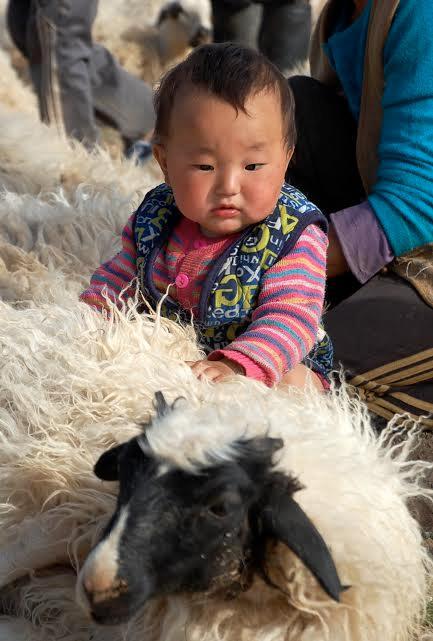
|
|
Girl pets the sheep, just
minutes before the shearing.
|
One of our visitors happens to be a
throat singer, and surprises us with an impromptu concert
of wistful love songs and ballads evoking the beauty of
the grasslands. Afterwards, we celebrate our friendship
with a bottle of white Bulgarian port we found earlier in
a little village store, which Bekbolat manages to uncork
with a screw from the jeep, and the string of his sleeping
bag.
Community Spirit
To survive in this vast and deserted
land, people have to be very creative and self-reliant.
But there is also an unspoken "law" that you always
share and help one another, regardless whether you know
each other or not. Several times, Bekbolat and Haba help
out with vehicles and motorcycles stranded in the middle
of nowhere by pushing, lending a tool, or providing oil.
We are heading for the “River of Wrestlers”
(named after famous wrestlers from the area, the biggest
of whom was placed on top of the nearby mountain after his
death; when people returned after some time, only his carcass
was left, but since the man had been so large, a wolf had
made its lair in the middle of his chest). Local people
warn us that crossing the river might be hazardous due to
excessive rainfall in previous weeks, so some good Samaritans
offer to accompany us with a big truck, and wait until our
jeep has safely reached the other side of the river.
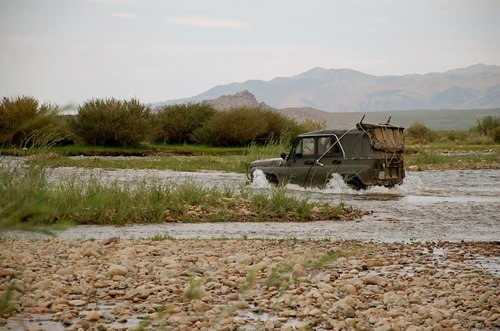
|
|
Jeep 4x4 crossing the river.
|
Nadaam
Standing in the middle of an extensive
valley while on a mission to spot cranes (half of this endangered
species’ world population inhabits the Mongolian steppes),
we suddenly see a huge cloud of dust rising up from the
horizon. Soon we are surrounded by a large group of young
boys on horseback, galloping toward the start of their horse
race somewhere in the far distance. The race is part of
a mini-Nadaam festival, celebrated in the countryside a
few days prior to the famous Nadaam celebrations in the
capital.
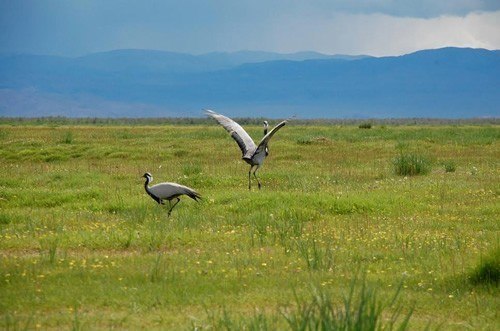
|
|
Spotting cranes while standing
in the valley.
|
At the finish grounds, nomads in their
most ostentatious outfits walk around to watch and be watched,
often parading with one of their well-groomed horses. Others
hold pick-nicks, drink airag (fermented mare’s
milk), and chat and laugh together in anticipation of the
arrival of the young jockeys. When they are finally in sight,
everyone rushes at once to the finish. There is a common
belief that if you are covered by dust or touch the sweat
of the winning horse, you will have a successful year ahead
of you.
Eagle Hunter
Bekbolat has asked around several times
for a Golden Eagle hunter, and he is finally able to track
one down on the last day of our trip.
The Kazakh, with his light green piercing
eyes and aquiline nose eerily similar to his animal, brings
us to the huge brown bird, tied with a long leash to a stone
outside. He slips a thick gauntlet over my underarm, pops
a hood on the fluttering eagle’s head to cover her eyes,
and before I know it, I am carrying his pet weighing in
at a full 15 pounds.
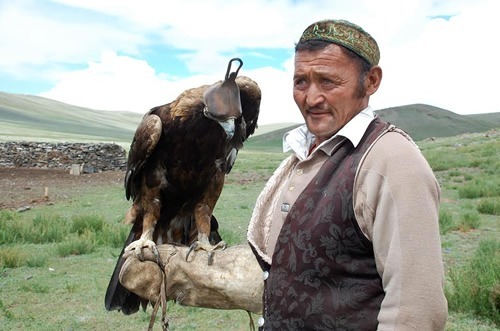
|
|
Mongolian eagle hunter carrying
a Golden Eagle.
|
Unfortunately, there is no hunting in
summertime. The eagle is "on vacation," and fattened
up until the winter season starts again. Instead, we will
have to content ourselves with the hunter’s spicy stories
while we enjoy his wife’s hearty mutton meal inside the
ger.
He explains how eagles are caught when
they are young, sometimes still nestlings, because then
they are easier to train: letting them sit (hooded) and
fast for some time until they are so starved that they get
eager enough to hunt. Although eagles can live for up to
forty years, they are not kept longer than 10 years, after
which they are let go to breed. Generally, only female eagles
are used for hunting, since they are more aggressive and
weigh heavier than their male counterparts; males are sometimes
used for boys to learn on, or for catching females.
Eagles hunt marmots, rabbits, foxes,
and even wolves. The hunter maintains that wolf hunting
is permitted in Mongolia because they are not considered
an endangered species. On the contrary, wolves multiply
fast, have big litters, and are the prairie’s biggest enemy,
killing, and eating entire livestock. Their pelt is sold,
and their meat consumed.
“You should come back in wintertime,”
suggests the eagle hunter when we say our farewells. “Our
horses are easy to ride, and excellent mountain climbers.
Come and stay for a couple of days with our family, so we
can take you on a fox hunt.”
That certainly does not fall on deaf
ears, and while we make our way back to Olgii in the late
afternoon sun, I am already fantasizing about my return
to this fascinating corner of Mongolia’s Wild West.
|
For More Good Info
-
My trip through Bayaan
Olgii was perfectly executed by Altai Expeditions.
-
Flights to Ulaan Baatar
usually depart from Beijing or Seoul.
-
Modest gifts for hosts
are appreciated. Keep it small and light, in
order not to exceed the 15 kg (32 lb) limit
on local flights (hand luggage included!).
-
Summer months are from
early June until mid-September with temperatures
in the mid twenties, a lot of sun, occasional
rain, and generally cool nights.
-
Nadaam festivities are
held each year around the 12th of July; the
Golden Eagle Festival in Olgii usually takes
place in the end of September.
|
Lies
Ouwerkerk is originally from Amsterdam,
The Netherlands, and currently lives in Montreal,
Canada. Previously a columnist for The Sherbrooke
Record, she is presently a freelance writer and
photographer for various travel magazines.
|
